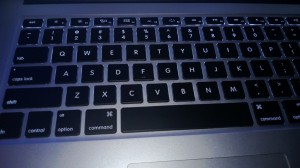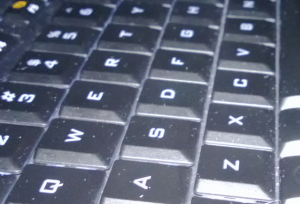My short fiction piece Dark Fiber is now available from the Oklahoma Review.
Category Archives: Gadgets
The Working Writer, 2012 Edition (Part 2 – The Tablet)
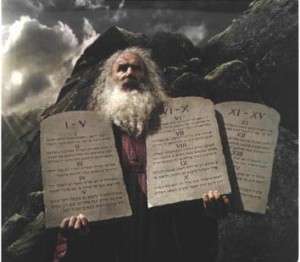 Tablets aren’t just tools for recording the
Tablets aren’t just tools for recording the fifteen ten commandments! Now everybody can pretend to be a futuristic nerd on Star Trek. Or you can ruin your finger trying to tap out the Great American novel. Tablet computing can be a wonderful extension of your laptop writing environment, provided you understand a few constraints. Chiefly, that tablets are media consuming devices, not so much for media creation. Most tablet manufacturers are more concerned with making episodes of Honey Boo Boo look good than helping you edit your prose. I’ll be discussing what makes a good tablet, which ones to avoid, and suggest some ways you can edit and write on the go.
Connectivity is really important when you’re writing while waiting in the check-out-line for that lady with a hundred coupons. Can you get to the data you need? Can you access the internet? Can you stream that video clip of the sneezing baby panda? Tablets today support one of two connection methods – wi-fi or cellular (3G/4G), and quite a few support both. Having flexibility with accessing networks can be a huge benefit. With wi-fi capability, you’ll need to be within proximity of a wireless network, and you’ll need to know the authentication information. Most public wi-fi hot spots require an extra layer of credentials typically passed through a web browser. You log onto the network, but have to open a browser and either buy access or agree to the acceptable use policy before you can connect. This can be a problem if the site requires a software download, or the authentication screen isn’t compatible with your browser. If you’re using a Kindle (not a Kindle Fire), you don’t even have a browser capable of looking at the use screen! Nearly all tablets can support wi-fi access today. For the few that use cellular, access isn’t an issue, but data streaming is. Cellular connectivity typically comes with data caps. Going beyond the cap incurs extra charges. There are plenty of horror stories where folks get hit with a bill that’s thousands or tens of thousands because they were streaming video or out-of-country. Check with your cellular provider to figure out exactly what your data cap is, and make sure you’re careful not to hit it!
Not only will you need connectivity, but unless your tablet is your primary or only writing device, you’re going to need some way to access your work in progress or send your updates back to your laptop. Fortunately there are a few methods to choose from.
With most tablets, the easiest way to send and receive story info is e-mail. Typically opening an attached document opens a corresponding application (or prompts you to browse a store to find one), and most applications for writing/authoring support a submit-to–email function. Sites like Dropbox and Google Docs offer desktop and tablet features that let you upload files and share them between devices. If you’re using Windows 8, you automatically have access to Microsoft Skydrive, which does the same thing. No Windows 8 but you’re using a PC? Sign up for Skydrive today!
Hardware Specs for tablets aren’t the same as other computing devices. Most tablets today have to run on low-power processors, and while they’re getting better each generation, don’t expect the same performance you’ll get from an actual desktop/laptop solution. For the most part, you shouldn’t worry about the processor. What you need to worry about is the storage. Hard-disks have spinning and moving parts, which eat up precious battery power and tend not to react well when shuffled around all the time. Hence, most tablets today use solid-state storage. Since solid-state storage is expensive, you probably won’t get much. Current tablets range from 8 gigabytes (barely enough to store an episode of Jeopardy) to 256 (enough to bring along your entire collection of Polka MP3’s, even the rare German translations). For most tablets, somewhere between 20-64 gigabytes is plenty. You want enough room to store your data and apps, plus all the great Manimal episodes once they’re made available. Oh, wait… there weren’t any great Manimal episodes.
Tablets now come in three basic flavors of operating system: the Apple iOS, Android, or Windows. It’s easier to talk about them in terms of OS since you’re buying into a market of available apps. All three OS’s have a marketplace where you can buy and download apps and media, but not all apps and media are available on all systems.
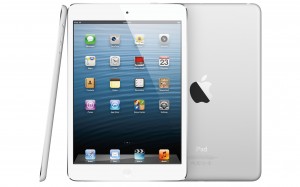 The Apple iOS and iTunes marketplace are perhaps the most mature, and easily win a prize for the most available software. The iPad has the luxury of being the first device to get tablet computing right, and they’ve had a few years to perfect the design. The latest models pack Retina – Apple’s ultra hi-def display which is intended to mimic the resolution the human eye can see. Words look sharper, colors crisper, and everything is easier on your eyes. For the most part, it’s true. Retina does make a difference, especially with text – which is what we’re talking about. Unfortunately Retina requires additional battery power, and most retina-aware apps need additional storage space to hold hi-resolution images. But we’re writing, remember, so that won’t affect our writing apps. Just occasional sessions of Infinity Blade when we get writer’s block. Retina-enabled iPads (3rd generation or newer) have a display that’s bright enough to be seen outdoors, which is great when you’re stuck next to the window seat on a long flight and want to start your novel on elf-torture. The iOS operating system is fairly intuitive and easy to navigate. The learning curve is fairly straightforward, and the interface is very polished. Some functions can be a bit harder to figure out (holding down an icon to enter “edit” mode, double-tapping the iOS button to see background apps, etc.), but an average user can likely pick up an iPad and start writing in minutes.
The Apple iOS and iTunes marketplace are perhaps the most mature, and easily win a prize for the most available software. The iPad has the luxury of being the first device to get tablet computing right, and they’ve had a few years to perfect the design. The latest models pack Retina – Apple’s ultra hi-def display which is intended to mimic the resolution the human eye can see. Words look sharper, colors crisper, and everything is easier on your eyes. For the most part, it’s true. Retina does make a difference, especially with text – which is what we’re talking about. Unfortunately Retina requires additional battery power, and most retina-aware apps need additional storage space to hold hi-resolution images. But we’re writing, remember, so that won’t affect our writing apps. Just occasional sessions of Infinity Blade when we get writer’s block. Retina-enabled iPads (3rd generation or newer) have a display that’s bright enough to be seen outdoors, which is great when you’re stuck next to the window seat on a long flight and want to start your novel on elf-torture. The iOS operating system is fairly intuitive and easy to navigate. The learning curve is fairly straightforward, and the interface is very polished. Some functions can be a bit harder to figure out (holding down an icon to enter “edit” mode, double-tapping the iOS button to see background apps, etc.), but an average user can likely pick up an iPad and start writing in minutes.
The native notepad app supports send-to-email, but is pretty skimpy on features. You can use it for capturing some quick ideas, and not much else. One of the best writing apps for iOS is easily Pages. A fairly standard word processor, Pages can do all the basic editing and picture-inserting you want, and even comes packed with a few nifty templates. There aren’t a whole lot of formatting options available, and simple changes like tabbing, bolding, or italicizing require some finger-flexing that may break your train of thought (negated if you spring for a keyboard). Microsoft Word isn’t available on iOS, though it’s been rumored for years. There are a few other apps like simplenote and evernote and textexpander, but they’re more not-taking and organizational apps. Manuscript is worth looking at if you’re writing long prose, and there’s even a script-writing app so you can write Lethal Weapon 7 (or 8? I forget where they left off).
On the down side, iPads have few connectivity options, and no expansion/memory/card slots. While there is a camera USB connector, don’t expect a thumb-drive to work. Current generation ipads use the new Apple Lightning connector, which so far has a huge premium on accessories and won’t work with any of the old iPod/iPhone/iPad accessories. Want a car adapter? $60. Lose your USB connector? $40. And while writing apps are available, there aren’t a while lot of options that are easy for the mobile writer to use. Cost is also a factor. Expect to pay $499 to $849 depending on your storage and wireless options. The good news is that used iPads are still decent machines. It’s fairly easy to wipe the operating system and delete the previous owner’s Polka collection, so picking up a low-res iPad 1 should be a viable option.
Recommended: Pages (for editing/writing), and Dropbox for sending your work back and forth. That, or e-mail always works. To make your life better, pick up the Apple Wireless Keyboard. Your tapping-finger will thank you.
Microsoft Windows RT/Windows 8 tablets started hitting the market in December, and lots more are on the way. Microsoft hasn’t entirely fractured the marketplace with two different tablet operating systems, but there are some things you should be aware of. Both versions look pretty much identical, both connect to the windows Marketplace, and both can run any app in the marketplace. Windows RT has been compiled for ARM processors, which are lower-power systems with great battery life. There are some excellent Windows RT tablets available now, and they’re pretty much all priced lower than iPads. What’s even better is that Microsoft Office is available for both RT and Windows 8. If you’re already familiar with Word, you’re good to go!
Windows 8 tablets are slightly different animals. They run the full Windows 8 operating system, which means you have access to all Windows applications. All Windows Applications. Let that sink in for a minute. The potential is enormous! Finally your 1998 floppy-disk edition of Encarta won’t go to waste! Well, not so fast. Windows 8 tablets will run Intel processors and potentially all Windows applications, but they’re still not fully ultraportable machines. There are no floppy drive add-ons. Floppy-drive aside, running the full Windows 8 OS on a tablet is a great experience. Getting to a desktop or browsing through operating system files seems kind of strange on a tablet, but if you’re already familiar with Windows you won’t have much adjustment.
Lots of Windows tablets have USB ports and expansion card slots. Slipping your camera card right into your tablet can really simplify things, and connecting a USB mouse is possible, though using it with a tablet can seem weird. Still, it’s nice to have options.
Microsoft has led the way with Windows tablets by building the Surface. Currently only available through the Microsoft site, the Surface will be coming soon to a retail outlet near you. Or within your general proximity. Or maybe just an international flight and four-hour car ride away. The Surface Pro has yet to hit the market as of this writing, but it’ll be available later in January with some impressive hardware specs. One of Surfac’s best features is the cover – available in Type or Touch style. The tablet cover becomes your keyboard. Touch covers are just that – very little trigger distance, and can feel uncomfortable when typing for longer periods, but are still far better than tapping on a screen. The Type cover sports an actual cissor-switch keyboard and is more comfortable, but still not as nice as using an actual laptop. Writing on a Surface with a Type cover for several hours was far easier for me than using an iPad with a remote keyboard.
All this power comes with a price that isn’t just cost. Windows 8 tablets will not have the same battery life as Windows RT machines. Even Intel’s best low-power processors aren’t quite mobile-processor efficient. Battery life will vary by vendor, but expect anywhere from 2-10 hours depending on what you’re doing. Surface tablets start at $499 putting them right in line with an iPad, and the top-of-the-line Surface Pro will run around $999. That’s laptop-price territory, but you do get an incredibly powerful and flexible machine. Unfortunately none of that power is necessary for writing… but hey, you can play World of Warcraft and skip out on your writing career. Or connect an XBox controller and make it the ultimate gaming machine while in bed! Annoy your significant other with clickity-controller sounds all night! Then sleep on the couch! Then take up drinking during your divorce! Then write about it on your Windows Surface Pro!
Recommended: Surface RT or Pro tablet, Microsoft Word for writing, and Skydrive for sharing content.
Android Tablets aren’t great mobile writing devices for the average writer. I may enrage the entire internet, but that’s my opinion. Plus my dad can beat up your dad. The Android marketplace is fractured with multiple app stores, features can vary widely between devices, and you have to be somewhat IT savvy to navigate the landscape. One of the best Android tablets (certainly the best known) on the market is the Kindle Fire, which is more an extension of Amazon’s streaming content service than anything else. The Kindle Fire is light, has a decent screen, and is easily the cheapest tablet available. But understand what you’re buying – Amazon is relying on the cloud for storage and processing, and will only let you browse the Amazon Android app store – not all Android apps are on the list, making the flexibility very limited. The Fire is a great content tablet if that’s what you want, but not so great at writing. The few writing apps available are more for note taking than writing. And when your internet access is down, you won’t have much content available. There’s hardly any local storage.
The Samsung Galaxy Note 10 is a fairly decent, lightweight and sturdy tablet, and comes with a pen that makes hand-scrawling your next novel fairly easy (nobody would have to re-type what you wrote). The Asus Transformer comes with a combo keyboard/trackpad making it essentially a laptop.
Recommended: Samsung Galaxy or an Asus Transformer. On the app side, Writer and Google Docs are worth looking at. Evernote and Springpad and a few others are really note-taking apps not well designed for writing more than ideas.
 And finally, I’d be remiss if I didn’t mention security. Tablets are computing devices. Anything that runs software is subject to vulnerabilities, and hackers are targeting tablets more and more. While there aren’t (yet) requirements for running antivirus and firewalls on tablets, that day may come. You should be aware of how your tablet can be compromised. Web browsing is still the number one method, and affects all tablets on the market. Vendors are typically quick to plug the holes, but safe browsing is still advised. The next method attacks use is the marketplace. Some malicious apps can compromise your system without you knowing. Both Apple and Microsoft have strict policies for their respective marketplaces, and both companies review software before it’s made available. While that doesn’t mean malware can’t slip through, it’s much less likely to happen and more likely to become public when it does. With Android, however, it’s the wild west. With great freedom comes the possibility of great corruption, and that “tap-to-fart” app may very well send all your personal info to a teenager in Shanghai who’ll use your credit-card to buy videos of virtual strippers. Don’t corrupt underage Shanghai hackers. Check out your apps before you buy them.
And finally, I’d be remiss if I didn’t mention security. Tablets are computing devices. Anything that runs software is subject to vulnerabilities, and hackers are targeting tablets more and more. While there aren’t (yet) requirements for running antivirus and firewalls on tablets, that day may come. You should be aware of how your tablet can be compromised. Web browsing is still the number one method, and affects all tablets on the market. Vendors are typically quick to plug the holes, but safe browsing is still advised. The next method attacks use is the marketplace. Some malicious apps can compromise your system without you knowing. Both Apple and Microsoft have strict policies for their respective marketplaces, and both companies review software before it’s made available. While that doesn’t mean malware can’t slip through, it’s much less likely to happen and more likely to become public when it does. With Android, however, it’s the wild west. With great freedom comes the possibility of great corruption, and that “tap-to-fart” app may very well send all your personal info to a teenager in Shanghai who’ll use your credit-card to buy videos of virtual strippers. Don’t corrupt underage Shanghai hackers. Check out your apps before you buy them.
The Working Writer 2012 Edition (part 1)
Unless you plan on piercing your finger and scrawling in blood every time the muse strikes, you’re going to need some tools to get the job done. My career in information technology (IT) seems to attract a deluge of questions about personal computers, operating systems, and nifty tools. My answers, depending on what kind of party it is and how free the alcohol is flowing, will range from insightful to snarky.
In the next few articles, I’ll talk about the tools modern writers can use to help them. If you’re shopping for a new laptop, tablet, or if you’re insane enough to write a novel on your cell phone, I have some suggestions to make your life easier. I’m going to be making a lot of generalizations, so if you work in IT you’ll indulge me.
First, let’s get the booze out of the way. Writing is a fantastic excuse to have a few drinks while you’re checking Facebook. Social media aside, writers have a long history of loving their booze, from Hemingway to Hunter S. Thompson, drinking and writing seem to go together like bacon and cheese, bacon and ice cream, bacon and smoked turkey. Bacon flavored alcohol doubly so. Truth be told, recent studies show that moderate amounts of alcohol can improve your creativity. The trick is moderation, something I’m not remotely familiar with but I will try to write about anyway. Just try to control yourself, otherwise you’re likely to fall into a fit of depression and consider the Hemingway solution as a crowning achievement to the peak of your writing career.
Let’s discuss laptops. Unless you’re ancient (like, mid-40’s or something), you probably know that modern laptops have really replaced desktop computing in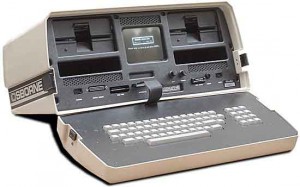 terms of available power and cost. But when shopping for a laptop, what should you look for? There’s so much to choose from, which ones work for writing? Which ones have good keyboards? Which ones can store your collection of Polka and Rockabilly classics? Let’s break it down into a few basic categories:
terms of available power and cost. But when shopping for a laptop, what should you look for? There’s so much to choose from, which ones work for writing? Which ones have good keyboards? Which ones can store your collection of Polka and Rockabilly classics? Let’s break it down into a few basic categories:
1. Brand: The easiest breakdown with brand relates to operating system. Either you like Macs, or you like real computers. I’m partially kidding. When shopping for a computer, it’s good to be educated about the brands out there. First and foremost, steer clear of retail. You’re going to pay too much overhead. Shop at sites like Newegg, Amazon, Buy.com, or directly from the manufacturers sites.
Apple makes great laptops. They’re sturdy, the Mac operating system is relatively easy to use, and there are some great writing tools available. Macs are stupid expensive though. And if you’re not web or techno-savvy, you may end up shorting yourself. Most journals, editors, and agents want submissions in Word. Microsoft makes Office for Mac, but it’s easy to save the wrong version and upload incompatible files unless you’re familiar with the operating system. The new Retina displays are easy on the eyes and have a resolution and backlight that reduces glare in direct sunlight. Mac keyboards are the chiclet-style with low trigger distance but are fairly comfortable to use. Bottom line, Macbooks make great laptops, but be prepared to spend nearly twice what you’d spend in an equivalent PC.
On the Windows side, there are one hojillion manufacturers of laptops. The big named brands include Dell, Sony, Toshiba, HP, and Acer. Sure, there are others, including some boutique manufacturers, but those are the biggest. On the PC side, brand really matters little. It’s the hardware that’s important.
We can’t talk about Windows PCs without mentioning Windows 8. The latest OS from Redmond is quite possibly the best, leanest, cleanest version of windows yet! it also sports an interface that’s nearly disastrous. Gone is the Start button and Start menu, replaced now with the Charms bar and Metro screen. It’s sufficient to note that it’ll take a bit of getting used to, and it’ll be much easier if you have a laptop with a touch screen. Most of the newer laptops shipping with Windows 8 have touch screens, so you’re going to be just fine in that arena. Otherwise, do yourself a favor and stick with Windows 7, or consider an application that puts the classic windows Start menu back in place, like Start8 from Stardock. It’s a testament to Windows 8’s failure to live in two worlds when you need a third-party application to make your machine functional. But if you have a touchscreen, or you’re using one of the new Windows 8 tablets, you’re going to love it.
2. Keyboard: I put this second since we’re talking about writing. Unless you’re in the market for a typewriter (and if so, you’re probably too old to be on the internet), then the keyboard is one of the most important decisions you’ll make in a writing laptop. Nearly all writing laptops are scissor-switch. Typically what that means is a short travel distance to trigger, and a responsive feedback (spring-ness). Either you like scissor-switch, or you don’t. Plenty of writers really like the old IBM style clickity-keys. The ones that make a satisfying KERCHUNK when you press them. You won’t find such a thing in a laptop, but there’s no reason you can’t spring for a USB keyboard either.
Next, consider the style of keys. Chiclet-style keyboards are the latest fashion in laptops. Usually they’re scissor-switch, and typically have some spaces
between the keys. I prefer chiclet keyboards, as standard scissor-switch keyboards where the keys meet up can snag if you’re a lazy typist or are writing particularly fast. With some standard scissor-switch boards, it’s possible to drag the edge of your finger along a separate key, tugging the key up. Over time, this can loosen or even break the key off. I haven’t seen many newer keyboards with this issue, but I had a Toshiba years ago that suffered from that problem.
Backlit keyboards are either illuminated around the keys, or from within the keys themselves. Usually manufacturers employ one or more white LED lights that generate little heat. The keys have clear plastic spacers that join the printing to the backlight assembly. This means you can type in the dark. Since most QWERTY typists don’t really look at their keyboards, this may seem like it’s of limited use, but trust me – when you’re writing in the dark and need to hit SHIFT-F7 (thesaurus in Word), or lower your volume or hit PRINTSCRN, you’ll be glad you have a backlit keyboard. It’s becoming a standard feature, so you’re likely to find them everywhere.
Bottom line – if you can find a similar laptop in retail, test out the keyboard before you buy it.
3. Type: Manufacturers like to break laptops down into distinct categories. They’ll throw out funky names like Ultrabook, Laplet, or Mobile Workstation or some other silly name. As far as I’m concerned, if it looks like a laptop, it’s a laptop. Ultrabooks are Intel’s attempt to push manufacturers to build something that resembles a Macbook. Laplets are usually tiny laptop/tablet hybrids, and I haven’t yet seen one that doesn’t suck. Smaller mobile laptops usually sport cramped keys. if you have Sasquatch hands, are prone to fat-fingering, or are a lazy typist who doesn’t completely lift fingers when traveling to the next key, you’ll want a regular sized keyboard in your laptop. What’s considered Full Size usually means the number pad is next to the keys. Unless you’re an accountant, that’s probably not going to be much use to you.
4. Processor: There are two major (well… as of this writing) processor manufacturers – Intel and AMD. Intel produces the fastest, most power efficient processors. AMD chips are usually less expensive, but you get what you pay for. I have trouble recommending AMD, especially since the company is on the verge of bankruptcy.
On the Intel side, nearly all Intel chips are multi-core. That translates to multiple processors on a single physical chip. Each core can handle separate instructions, and some programs can take advantage of that. Think about it like check-out lines in the grocery store. One line is slow, but everybody gets served. Two lines are better because the clerks can check people out simultaneously. Having some extra lines for limited item customers is even better. Plus you can have bacon only lines which… I’m getting off track. Multi-core processors let you write while you’re downloading the latest episode of Mad Men in the background, or write and listen to iTunes at the same time without making your processor beg for a break.
Actual processing speeds mean little anymore. Intel produces processors in different “classes”. The Core i3 series are budget targeted, and usually have less cores and less power. Core i5 is usually the best price/performance and will last you a few generations. Core i7 is typically enthusiast aimed – for the folks that do lots of things simultaneously and need the fastest processor available.
5. Video Cards: You’re not buying a laptop capable of playing Call of Duty: Kill All Humans Edition, so the video card shouldn’t factor too much in your buying decision. It’s worth noting that discreet cards are far better than shared memory cards. The Intel video chips use shared memory, and render images as quickly as a constipated ninety-year-old. You’ll end up thinking your laptop is slow and crappy when it’s probably just your underpowered video card. While Word and other programs don’t exactly push the pixels, the video card comes into play when you’re browsing the net and looking at those lovely full-page ads for Bacon Memorabilia. We’re shifting into an era where the video card has become one of the processor cores, which makes this less of an issue. If you can, get a system that has a discrete video card. This is more important when you’re buying a second-hand laptop.
5. Memory: Computers are stupid, kind of like idiotic puppies who can’t follow instructions past some basic “Sit, Stay, Beg” commands. Computers need memory to store programs and help remember what it is they’re doing. The more RAM you have the better, up to a point. I recommend a minimum of 4 gigabytes (4GB) of memory for any modern computer. 8 gigabytes is preferred (8GB). Anything more than 8 is great, but overkill. If your running Windows Vista or Windows XP, or you have a 32-bit version of Windows, you should know that Windows cannot address beyond 2 gigabytes of memory. Windows 7 has some tricks around it, but it slows everything down. Bottom line, stick with Windows 7 64-bit and aim for 4-8 gigs of ram.
6. Disk Drive: Despite what you’ve heard, the “disk drive” is not your entire computer. Rather, it’s the way your computer remembers stuff when the power is switched off. It’s like a giant file cabinet. Today, there are two major kinds of disk drives: Solid State and Mechanical (and hybrid, but we’ll go into that later).
Solid State drives are like really big USB memory sticks. They’re extremely fast, and can greatly improve the performance of any computer. They’re also very expensive. You’ll usually pay twice as much for a Solid State drive that’s half as big as a mechanical counterpart. That being said, I think it’s worth it. Having your computer ultra-responsive is great, and writing doesn’t take up a lot of room so you’re not likely to fill it up. if you’re shopping for a solid-state drive or a solid-state laptop, I’d recommend no less than 64 gigabytes. 120 gigabytes seems to be the best price/storage space break point (at least for now), but SSD prices are falling faster than Lindsay Lohan’s career. The more storage you can get, the better.
Mechanical drives are made of thin magnetic platters. They look kind of like record players on the inside. There’s a mechanical arm that moves over the disk, and there are usually multiple platters where the information is stored. Being mechanical, these drives are slower. They’re usually rated in spin-speed. 5200 RPM is the standard. 7200 RPM is better, and offers improved performance but needs more power. 10,000 RPM drives are rare, and typically reserved for server products. You’re likely to find a laptop with a 5200 RPM drive that has twice as much storage space as a laptop with a SSD.
Hybrid drives are a variation of the two, the result of a mad drunken night between a mechanical drive and a solid-state drive. Hybrid drives usually have a chunk of solid-state storage with one or more platters. The logic engine in the drive sticks commonly used data on the solid-state portion. The user doesn’t have to do anything, and sees the entire disk as one drive. It used to make sense to have hybrid drives, but SSD prices have gotten so low that it’s better to go with an SSD option if you can.
7. Resolution: If you plan on writing with a laptop, it’s best to have a decent display that doesn’t hurt your eyes, has an adjustable backlight, and low glare. Plus, better resolution means your cats-who-look-like-hitler pictures will look better! Resolution is broken down to two sets of numbers – horizontal pixel count by vertical pixel count (or Width by Height). HDTV resolution is broken into two basic categories – 720p (1280×720) and 1080p (1920×1080). The “p” stands for Progressive Scan – every horizontal line will be drawn for every single frame. That gives you a smoother picture. 720i and 1080i also exist – the “i” stands for Interlaced – every other line is drawn every frame, giving a less clear image – but you won’t find interlaced in a laptop. Most laptops are 1680×1050 for a 15″ screen.
You’ll also need to consider screen size. A 1080p resolution is great, but on a 13″ laptop screen, will you really notice? 15″ screens are about as small as I can handle without straining my eyes. 17″ screens are better, but there’s a tradeoff between screen size and laptop weight. You can have a great resolution 17″ or 18″ laptop that’s easy on the eyes, but kills your shoulder because it weighs 10 pounds. With increased screen size comes more power requirements and reduced battery life.
The Bottom line: As a writer, you want a laptop that’s lightweight, powerful, has a decent screen and a comfortable keyboard. An Intel Core i5 processor with at least 4 gigabytes of RAM is a good start. A 15″ 1680×1050 screen (or better) will help your eyes adjust. A bright low-glare screen means you may be able to write outside in sunlight. Solid-State drives have less room to store your data, but are far faster making your laptop seem like it loads your latest story before you’re done clicking the file. Keyboards vary by preference, so find a style you’re comfortable with.
Here are some recommended examples – laptops I’ve either reviewed for a tech site, used at some point, or own:
Macbook Pro: Macs are expensive, borderline arrogantly elitist machines. Despite what the Mac fanatics want you to believe, the Mac operating system isn’t free of viruses. Caveats aside, the Macbook Pro Retina 15″ is a fantastic machine. All solid state (save some cooling fans), great keyboard, decent battery life, and good all around performance. The retina display is easy on the eyes and is one of the few displays visible in sunlight. But you’re going to pay for it. Expect to shell out anywhere from $1900-$2500 depending on your options. Available directly from Apple, Apple Retail stores, Best Buy and a few other brick-and-mortar outlets.
Dell Inspiron: The Inspiron series has a long and sordid history. The latest, the “z” series, has some decent examples. The newest 15z is a decent laptop for the money. As a writer, you won’t need anything better than the base model, unless you plan on editing video or playing the latest games in the best resolution… but if that’s the case then you aren’t writing, so why are you here? The base model 15z will run you around $700, available directly from Dell.
Toshiba Satellite U845: Toshiba doesn’t always make the best laptops, but the Satellite U845 manages to hit all the right notes. An Intel Ultrabook, the U845 is lightweight, chiclet-keyboard system with a 5400 RPM drive and decent processing power. Expect to pay around $800 for the base model, available from Newegg, Amazon, Best Buy, and a few other brick and mortar outlets.
Acer Aspire V5-571: Acer isn’t exactly a household name in the world of mobile computing, but they make some decent equipment. The Aspire V5-571 is one of the best ultrabooks on the market at a great price point – starting around $650. The keyboard is a bit closed in, but still functional. Definitely a worthy low-end option for the mobile writer.
And that sums up the laptop portion. Next up I’ll be looking at Tablet computing and writing software.

